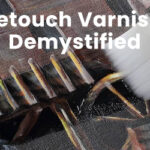Can You Speak like an Artist?
A Dictionary for the Struggling Art Viewer
Have you ever been looking at an art exhibit when the label catches your eye? You see the title of the piece, author, medium and then a description of the piece. Often the description of the piece will read something like this: 
“Above the artist expresses the banality of the subject with regard to the issue of content; the reductive quality of the purity of line spatially undermines the exploration of montage elements. It should be added that the metaphorical resonance of the figurative-narrative line-space matrix brings within the realm of discourse the inherent overspecificity. It’s difficult to enter into this work because of how the metaphorical resonance of the facture notates the larger carcass.”
When did you stop reading that sentence? Its not always the case, but occasionally, the language associated with art can be quite daunting to the casual viewer. To assist you in the social awkwardness of not understanding a specific piece or being able to talk with other art viewers about a subject matter, here is a list of terms that can help you describe any art piece:
The Ultimate Guide of Art-Speak:
Abstract: Of or pertaining to the formal aspect of art, emphasizing lines, colors, generalized or geometrical forms especially with reference to their relationship to one another.
Abstract Expressionism: A movement in experimental, nonrepresentational painting originating in the U.S. in the 1940s, with sources in earlier movements and embracing many individual styles marked in common by freedom of technique, a preference for dramatically large canvases, and a desire to give spontaneous expression to the unconscious. Think Jackson Pollock.
Chiaroscuro(chi-a-ro-scu-ro): The term for a contrast between light and dark.
Derivative: Not original. Secondary.
Hyper-reality: exxagerated in comparison to reality; when the reproduced takes place of reality.
Grisaille: A style of monochromatic painting in shades of gray.
Impressionistic:Stylistically characterized by short brush strokes of bright colors in immediate juxtaposition to represent the effect of light on objects or a manner of painting in which forms, colors, or tones of an object are lightly and rapidly indicated with little attention to details.
Interesting: What you can always say when you really have nothing to say about a piece that doesn’t strike your fancy or that you don’t understand.
Kinetic art: Art relating to or involving motion.
Machine aesthtic: An optimistic belief in the role of abstraction in human life, and an emphasis on machine-like, undecorated flat surfaces.
Metonymy: Naming an attribute or adjunct of the thing itself: “Crown” for royalty or saying “count heads” for counting people.
Metanarrative: Any story told to justify another story or a story about oneself that provides a narrative of one’s experiences.
Modern: Art that was produced in the late 1860s through the 1970s that rejected traditionally accepted forms and emphasized individual experimentation and sensibility.
Nude: An idealized version of the naked human form.
Realistic:A style where a treatment of forms, colors, space, etc. is in such a manner as to emphasize their correspondance to actuality or to ordinary visual experience.
Relational art: Often performative and interactive techniques that rely on the responses of others: pedestrians, shoppers, casual observers who become observers-turned-participants.
Semiology: An omen, mark, sign, or trace.
Semulacrum: A vague representation, a semblance, or likeness to an object, person or place.
Sublime: of such excellence, beauty, perfection as to inspire awe. Often accompanied with a sense of morality.
Synecdoche: A representation where the part is used for the whole or the whole for the part.
Now you too can walk the halls of museums and galleries without fear of not understanding what artists are saying to describe their art or exhibit. You can now say, “oh this piece is quite derivative” or “look darling, how sublime is this metanarrative?”
And if all else fails, you forget these helpful terms, you can always just ask the question “What really is art?”





